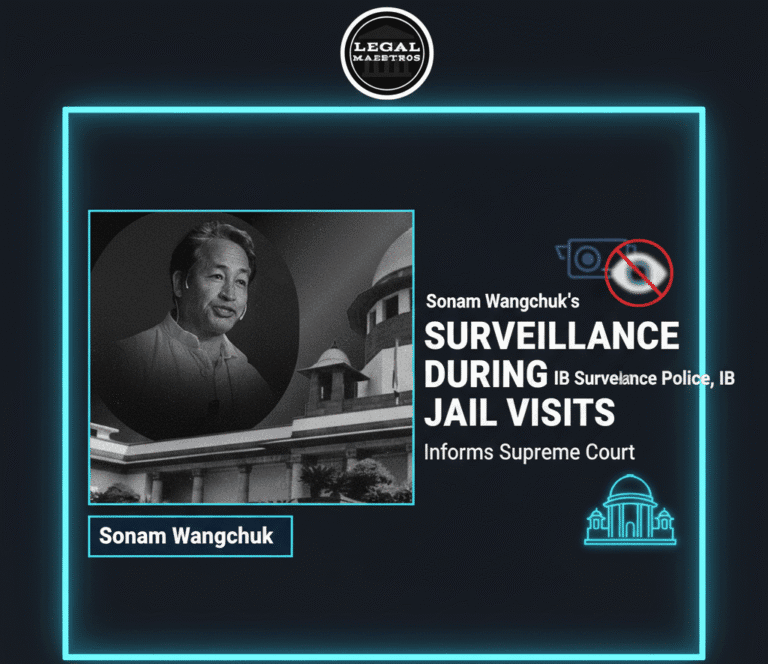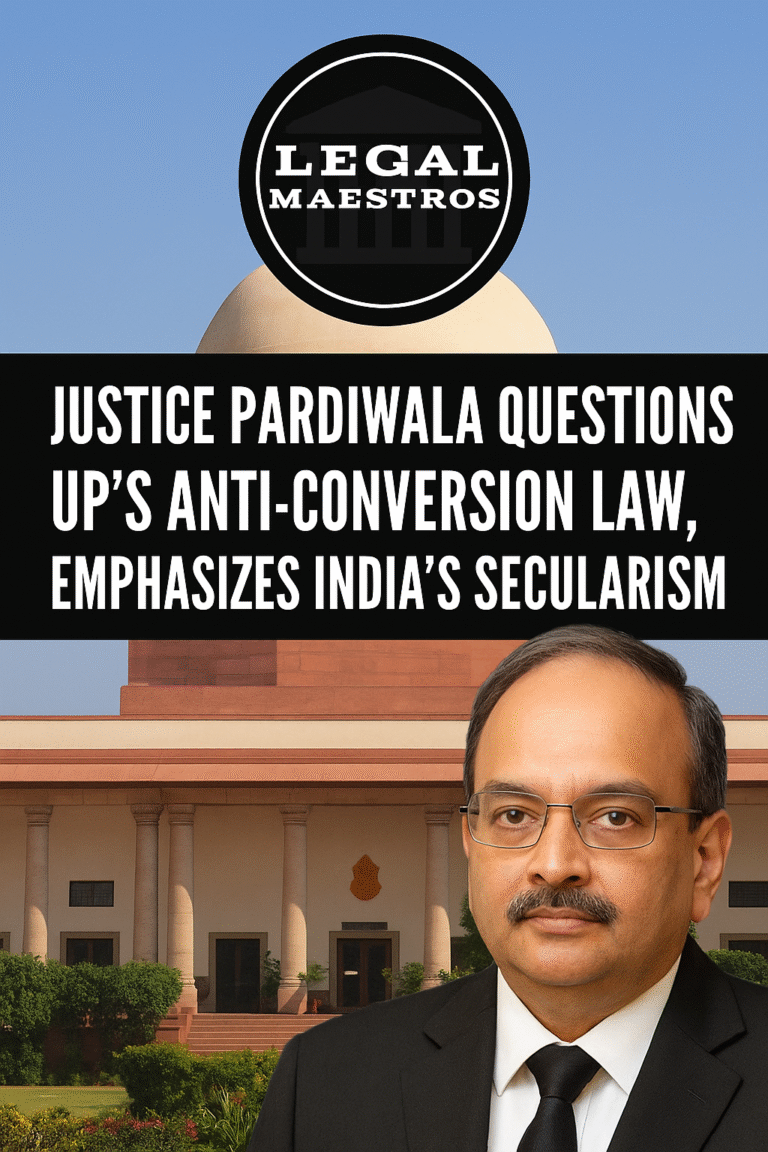
Supreme Court Mandates Minimum Practice Of 3 Years As Advocate To Enter Judicial Service
The Initial Point of Departure
In a landmark decision that was handed down on May 20, 2025, the Supreme Court of India reestablished the requirement that candidates must have worked as advocates for a minimum of three years prior to applying for entry-level posts in the judicial service.
This requirement was introduced in order to ensure that candidates are qualified for the positions. The Supreme Court arrived at the judgment that this minimum term of practice was required in order to ensure that newly appointed judges possess sufficient legal experience and are prepared to carry out their responsibilities in an effective way.
However, the decision does not have any bearing on applications or selections that were already in progress prior to the execution of the judgment. The decision is applicable to all future recruiting procedures, making it applicable to all future recruitment processes.
For any queries or to publish an article or post or advertisement on our platform, do call at +91 6377460764 or email us at contact@legalmaestros.com.
For More Updates & Regular Notes Join Our Whats App Group (https://chat.whatsapp.com/DkucckgAEJbCtXwXr2yIt0) and Telegram Group ( https://t.me/legalmaestroeducators )
An Explanation of the Procedures Used in the Administrative and Judicial Recruitment Process
Since the Constitution of India was ratified, under Article 234(1), High Courts have been granted the right to organize subordinate judicial services. This authority has been in place ever since the Constitution was approved. This authority has been in effect ever since the Constitution was taken into consideration.
The authority to “prescribe by rules the qualifications for appointment to such service and the methods of recruitment therefor” is granted to each High Court by this Article. This authority is conferred to each High Court. In accordance with Article 234, the State Judicial Service Rules have frequently incorporated age restrictions, educational criteria, and experienced professionals over the course of several decades.
For any queries or to publish an article or post or advertisement on our platform, do call at +91 6377460764 or email us at contact@legalmaestros.com.
These rules have been developed in compliance with the mandates of the Constitution. For the purpose of ensuring that those who are interested in pursuing a career in the judiciary have a sufficient amount of experience in the courtroom, the High Court of the United States enforced the need that they complete three years of practice in order to fulfill the conditions.
Conclusions reached by the Supreme Court of the United States
In the case that was brought up by the All India Judges Association, a Constitution Bench that was chaired by the Chief Justice of India, B.R. Gavai, and including Justices A.G. Masih and K. Vinod Chandran, reviewed earlier verdicts that had eased the experience barrier. The matter was brought forward by the All India Judges Association.
The Supreme Court made the observation that judicial officials who are burdened with the responsibility of settling complex disputes and managing court operations require a large amount of experience working in the courtroom as well as a comprehensive legal education. For the sake of carrying out “complete justice,” the Supreme Court reinstituted the three-year practice requirement and made it abundantly apparent that the term of practice could be recorded beginning from the date of provisional enrollment as an advocate. This was done by invoking the authority that was provided to it under Article 142 of the Constitution.
For any queries or to publish an article or post or advertisement on our platform, do call at +91 6377460764 or email us at contact@legalmaestros.com.
It is also necessary to provide evidence of practice and to enroll in provisional classes.
As stated in Section 24 of the Advocates Act, which was enacted in 1961, an individual is entitled to become an advocate provided they meet the specified academic criteria and enroll with a State Bar Council. This statement was made in accordance with the Advocates Act. The Act has a number of provisions, one of which is the provision for provisional enrollment under Section 26.
During the time that they are waiting for full enrollment, graduates are permitted to begin practicing thanks to this rule. Under specific conditions, the Supreme Court has reached the conclusion that the practice period for eligibility to serve in the judicial system may lawfully begin from the date of provisional enrollment. This decision was made. Candidates are required to provide a certificate that has been countersigned by a judicial officer of the relevant district or High Court.
The certificate must be issued by a senior advocate who has been practicing for a minimum of ten years. For the purpose of providing evidence that they have been practicing for a period of three years, this is done.
For any queries or to publish an article or post or advertisement on our platform, do call at +91 6377460764 or email us at contact@legalmaestros.com.
An exemption for vacancies that are still being filled in organizations
Applicants who had already filed their applications or who were in the process of being selected at the time that the ruling was handed down from the court were taken into consideration by the court. Furthermore, it was made clear that the reintroduced condition will not be applicable to any recruitment drive that is initiated prior to the 20th of May in the year 2025.
Taking this action was done in order to avoid upsetting any expectations that had been set up and any recruitments that were still in the process of being carried out. It is therefore acceptable for High Courts to continue with the selections that they have already made; however, the three-year practice rule must be reflected in all notifications that are made after its introduction.
The Rationale Behind the Benefits Obtained Through Practical Experience
It was highlighted by the Supreme Court that candidates for judicial positions do not absolutely need to possess merely a law degree in order to be well equipped for the obligations that they will be expected to fulfill.
For any queries or to publish an article or post or advertisement on our platform, do call at +91 6377460764 or email us at contact@legalmaestros.com.
Every day, practicing in the courtroom helps to nurture vital abilities such as the capacity to manage cases, produce legal papers, and master the art of asking and examining witnesses. These are all skills that are essential to the legal profession.
Additionally, judges are obligated to maintain a level of decorum within the courtroom and demonstrate sound judgment while making decisions about complex procedural issues. Advocates are able to absorb these practical components, which are crucial for rendering fair and informed verdicts, when they have accumulated experience over a period of at least three years. This can be accomplished by gaining experience in the field.
Making Certain That All States Have Standards That Are Comparable
Prior to this judgment, a number of High Courts had imposed a wide range of experience qualifications. For example, some states mandated a minimum of two years of practice, while others completely disregarded the requirement.
For any queries or to publish an article or post or advertisement on our platform, do call at +91 6377460764 or email us at contact@legalmaestros.com.
There is a lack of a national norm that is uniform, which poses a risk of uneven preparedness among judicial officials and has the potential to have a negative impact on public confidence in the system that is accountable for the delivery of justice.
According to the directive principles contained in Article 50 of the Constitution, which advocate for a unified civil code and harmonious legal order, the Supreme Court has supported consistency in eligibility conditions throughout all states by restoring the three-year criterion. According to the directive principles, this is in accordance with them.
Possible Consequences for Individuals Who Have Intentions of Serving in the Judicial Branch
The order of the Court highlights the necessity of planning one’s professional trajectory with the three-year practice term in mind for individuals who have recently graduated from law school or who have newly appointed themselves as advocates.
For any queries or to publish an article or post or advertisement on our platform, do call at +91 6377460764 or email us at contact@legalmaestros.com.
Individuals who have been granted temporary enrollment are now needed to ensure that their professional obligations are not disrupted and to maintain accurate records of their professional activities. Other requirements include maintaining accurate records of their professional activities.
It is expected that bar associations and legal mentors will play a vital role in supporting young advocates in satisfying this requirement. This will be accomplished through the facilitation of relevant training, moot courts, and opportunities for clerkships in courts and chambers.
Increasing the Strength of the Interface Between the Bench and the Bar Bench
Furthermore, the verdict highlights the reciprocal interaction that exists between the bench and the bar on the court. As part of its mission, the Supreme Court is working to establish a judicial system that values collaboration between the lower and higher courts and encourages procedural fairness.
For any queries or to publish an article or post or advertisement on our platform, do call at +91 6377460764 or email us at contact@legalmaestros.com.
Requiring a strong foundation of advocacy activity is the means by which this objective can be achieved. The fact that judicial officials have direct experience as advocates makes them better suited to understand the challenges that plaintiffs and practitioners face, which eventually results in more compassionate and balanced behavior on the part of the judiciary.
Changes to the Administrative and Regulatory Structure of the Organization
It is necessary to update the Judicial Service Rules of the High Courts in order to incorporate the criterion of recovered experience into the system. Administrative entities, such as State Public Service Commissions, are expected to change their recruitment notices and application forms in order to comply with the three-year practice rule.
Examples of such entities are the State Public Service Commissions. The idea of offering advice to assist State Bar Councils is something that the Bar Council of India may take into account in relation to the verification of provisional enrollment dates and the processing of certificates of practice for advocates who are looking for jobs in the court system.
For any queries or to publish an article or post or advertisement on our platform, do call at +91 6377460764 or email us at contact@legalmaestros.com.
Overcoming Potential Challenges and Obstacles To Be Confronted
However, despite the fact that it fosters better standards, it is probable that the verdict will result in difficulties during the changeover period. There exists a risk that certain applicants who are getting near to being eligible will be required to delay the submission of their applications.
As a method of alleviating the challenging circumstances, state governments and high courts ought to take into consideration the possibility of conducting a study into temporary remedies. These remedies could include structured mentorship programs or legal apprenticeships that count toward practicing requirements.
For any queries or to publish an article or post or advertisement on our platform, do call at +91 6377460764 or email us at contact@legalmaestros.com.
Aspirants can also be informed about the new criteria through information drives and seminars, which can also assist them in completing the requirements for the documentation that they need to submit.
In a broader sense, the significance of judicial quality has been brought to light.
There is a significant backlog in the legal system in India, and the public is starting to pay attention to the delays that are occurring. If newly appointed judicial officers are provided with extensive practical experience from the very beginning of their careers, it is feasible to contribute to more efficient case management and reduce the number of adjournments that are caused by procedural errors.
This can be accomplished by ensuring that they have substantial practical experience. In order to be in a better position to take measures that are meant to minimize the number of cases and ensure that justice is delivered in a timely manner, a group of judges who are well-versed in the reality of the courtroom are in a better position to have those measures passed.
For any queries or to publish an article or post or advertisement on our platform, do call at +91 6377460764 or email us at contact@legalmaestros.com.
In the process of generating competent judges, the Supreme Court’s decision to demand a minimum of three years of advocate practice prior to entering the judicial service is a reaffirmation of the significance of practical legal training. This decision was made in order to ensure that the judicial system is effective.
The Court has struck a balance between academic qualifications and practical experience by relying on Sections 24 and 26 of the Advocates Act and using Article 234 to enforce standard regulations. This has allowed the Court to determine the appropriate level of both. The Court took the necessary steps to attain this equilibrium.
As members of the legal community adjust to this ruling, it is absolutely necessary for bar councils, state high courts, and individuals who are interested in pursuing a career in the judiciary to collaborate in order to guarantee that the implementation will be carried out without any problems. This significant ruling has the ability to strengthen the foundations upon which India’s judicial system now sits. This can be accomplished by ensuring that the newest members of India’s judiciary bring both expertise and practical insight to the bench.
For any queries or to publish an article or post or advertisement on our platform, do call at +91 6377460764 or email us at contact@legalmaestros.com.



